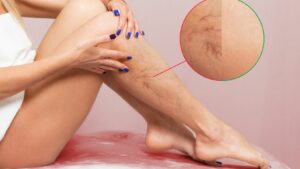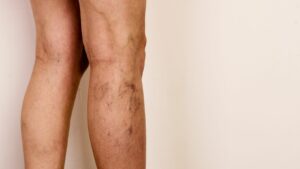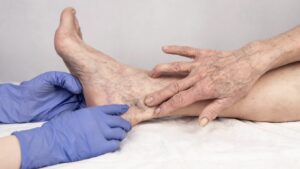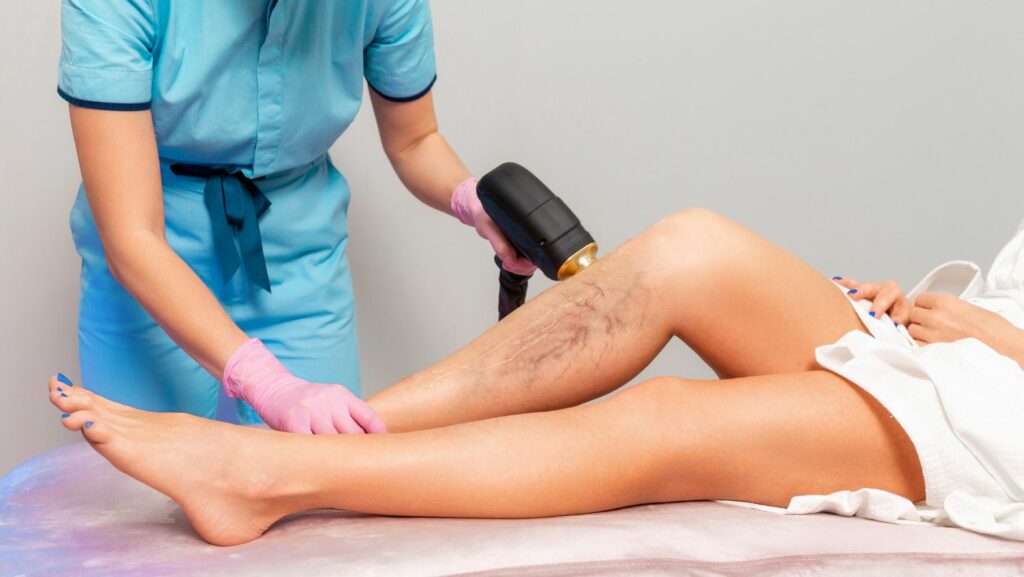![]()
![]() Laser Treatment Varicose Veins
Laser Treatment Varicose Veins
Varicose veins are enlarged, twisted veins near the skin’s surface. They frequently appear in the legs and feet due to increased pressure in the lower body. These veins result from weakened or damaged valves, which fail to effectively circulate blood back to the heart. Several factors contribute to the development of varicose veins. 
- Age: As people age, vein elasticity decreases, causing valves to malfunction.
- Gender: Women are more prone due to hormonal changes during pregnancy, menopause, or the effects of birth control pills.
- Family History: A genetic predisposition exists if close family members have varicose veins.
- Obesity: Excess weight increases pressure on veins.
- Standing or Sitting for Long Periods: Extended periods in the same position hinder blood flow.
Although often harmless, varicose veins can lead to discomfort and complications like ulcers or blood clots in severe cases.
![]() Overview Of Laser Treatment
Overview Of Laser Treatment
Laser Treatment Varicose Veins offers a minimally invasive alternative to traditional surgery. It uses focused light energy to treat affected veins, improving both health and appearance.
There are two primary types of laser treatments:
- Endovenous Laser Treatment (EVLT): This method treats larger varicose veins in the legs. A laser fiber is inserted into the vein
 through a catheter. The vein walls are heated and sealed, redirecting blood flow to healthier veins.
through a catheter. The vein walls are heated and sealed, redirecting blood flow to healthier veins. - Simple Laser Treatment: This technique targets smaller varicose veins and spider veins just under the skin’s surface. It doesn’t involve incisions and is often performed in a doctor’s office. Multiple sessions may be necessary for optimal results.
Laser treatment works by emitting targeted light energy. For EVLT, a small laser fiber is guided into the vein through an ultrasound-guided catheter. The laser’s heat closes the vein, causing it to collapse and eventually disappear. With simple laser treatment, focused laser beams pass through the skin to the vein. The damaged veins absorb the laser energy, causing them to fade over time. Both procedures effectively enhance circulation and reduce symptoms, offering a quick recovery compared to surgical methods.
![]() Benefits Of Laser Treatment Varicose Veins
Benefits Of Laser Treatment Varicose Veins
Laser treatment offers numerous advantages for those seeking relief from varicose veins. It presents an effective, modern option that enhances both health and aesthetics. Laser Treatment Varicose Veins is minimally invasive, offering a less traumatic experience compared to traditional surgery. By using focused laser energy, it eliminates the need for large incisions. This reduces the risk of infection and results in minimal scarring. As a result, patients often experience less pain and discomfort during and after the procedure.
Recovery from laser treatment is significantly faster than surgical methods. Most individuals return to their normal activities within a few days. This quick turnaround is possible because the procedure involves limited tissue damage.  Patients usually require less post-treatment care, making it an attractive option for those with busy lifestyles. Laser Treatment Varicose Veins, though minimally invasive, carries specific risks and side effects. Patients may experience mild discomfort during the procedure, such as a burning sensation or tingling. Skin irritation, including redness or swelling, commonly occurs post-treatment.
Patients usually require less post-treatment care, making it an attractive option for those with busy lifestyles. Laser Treatment Varicose Veins, though minimally invasive, carries specific risks and side effects. Patients may experience mild discomfort during the procedure, such as a burning sensation or tingling. Skin irritation, including redness or swelling, commonly occurs post-treatment.
In rare cases, patients might develop hyperpigmentation, where the treated skin darkens over time. Thrombophlebitis, inflammation of the vein, presents another potential complication. Some experience nerve damage resulting in temporary numbness or tingling, particularly in the legs. There is a slight risk of blood clots, which necessitates medical attention. Patients must discuss medical history with their healthcare provider to minimize risks, ensuring laser treatment aligns with their health profile and existing conditions.
Laser Treatment Varicose Veins presents a compelling option for those seeking effective and minimally invasive solutions. With its ability to target both large and small veins, laser therapy offers significant benefits in terms of reduced pain, faster recovery, and minimal scarring. Patients often experience a positive outcome, with improved appearance and relief from symptoms, making it a preferred choice over traditional methods. While some risks and side effects exist, they are generally mild and manageable. By consulting with healthcare providers and adhering to post-procedure care, individuals can achieve optimal results and enhance their overall vein health.

